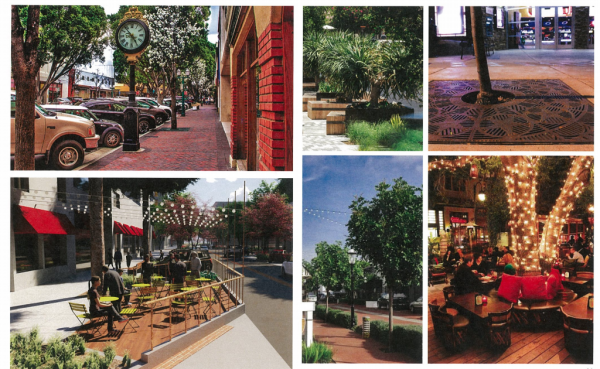By Daniel Langhorne, Special to the Independent
A plan to plant street trees and spruce up the streetscape in downtown Laguna Beach inched forward Tuesday, providing relief to residents and business owners who’ve complained about the commercial hub’s shabby appearance.

The Laguna Beach City Council offered preliminary suggestions on 20 public infrastructure projects that encompass most of the public realm in the 113-acre downtown. For example, city staffers and Laguna Beach-based landscape architects with SWA Group proposed planting 119 new trees and 115 replacement trees as a remedy for the removal of 12 percent of the downtown urban forest identified by arborists as being in poor health.
Laguna Beach was recently criticized by the Orange County Grand Jury as one of eight Orange County cities with a relatively low number of publicly-owned street trees. The proposed action plan would increase the number of downtown street trees from 593 to 712 trees.
Councilmember Sue Kempf said people often tell her they think the downtown is looking worn.
“I’m downtown all the time now and I really look at everything now with a pretty critical eye, and I do think it needs refreshing,” she said.
Altogether, the proposed streetscape improvements are expected to cost more than $10 million. The proposed improvements for lower Forest Avenue alone are slated to cost more than $1.1 million, including a pedestrian scramble intersection, replacement of a vehicle crash barrier with bollards, succulent gardens, metal grate tree wells, brick paving, new benches, and a new mid-block pedestrian crossing.
Councilmember Toni Iseman said she’s concerned about committing that much money in light of the multi-million dollar projects needed to improve antiquated sections of Laguna Beach’s wastewater system.
“It seems to me if we’re a family, we take a look at what our big issue is and that’s our big issue,” she said.
She urged city staff to prioritize relatively inexpensive proposals that will improve the downtown experience for residents and visitors.
“In the long term, this [action plan] is good, in the short-term, I think a lot of these things have to wait,” she said.
Among the short-term projects being pursued by the city is repurposing the Laguna Beach Transit Center at Broadway Street. City staff plan to negotiate with the Orange County Transportation Authority about early termination of the transportation agency’s lease within the next 12 months, said Shohreh Dupuis, assistant city manager and director of public works for Laguna Beach.
“I’m not sure that it’s a necessary element to our operation,” Dupuis said.
She added that security concerns were another consideration for closing the Transit Center.
OCTA has leased the property since 1980 and the active agreement is in place until June 2030. The transportation agency has not received a request to terminate the lease of the Laguna Beach Transit Center, OCTA spokesperson Eric Carpenter wrote in an email.
“In previous discussions, we agreed to work with officials from the city of Laguna Beach to evaluate future options for the center,” Carpenter wrote.
On Tuesday, Iseman envisioned using the transit center property for parking and affordable housing.
Pacific Galley co-owner Patty Bailey said she was excited to see a proposal to hang light stands across Forest Lane, the alley that runs behind her Forest Avenue storefront.
“It’s very dark and now that it’s getting a lot darker sooner, few people congregate around here,” she said. “We park back there and bad things tend not to happen in a well-lit area.”
Bailey added that she would appreciate seeing more plant life in downtown, but if a tree is flagged for being in poor health, then it should be removed.
Laguna Beach resident John Thomas argued that most of the benefits from the Downtown Action Plan will ultimately go to commercial building owners who will raise rents as the streetscape improves.
“Now is the time for the downtown building owners to step up and form a real business improvement district,” he said.
Mayor Pro Tem Steve Dicterow disagreed with Thomas’ argument that landlords will be the primary beneficiaries.
“Some of these things are not being done for the direct benefit of the building owners and the merchants—they’re being done to beautify, and I think that’s an essential government function,” he said.
Council members’ suggestions from Tuesday’s meeting will be incorporated into the Action Plan’s first draft, which will be presented to the Planning Commission in the first quarter of 2020.





If the city terminates their agreement with OCTA 9 years early is it going to cost something?